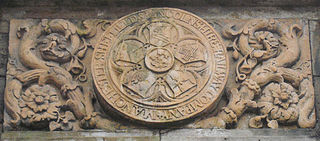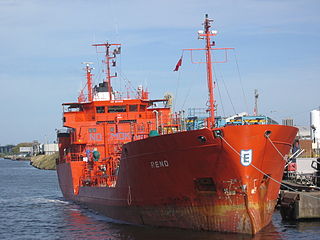
The River Mersey is a major river in North West England. Its name derives from Old English and means "boundary river", possibly referring to its having been a border between the ancient kingdoms of Mercia and Northumbria. For centuries it has formed part of the boundary between the historic counties of Lancashire and Cheshire.

The Manchester, Sheffield and Lincolnshire Railway (MS&LR) was formed in 1847 when the Sheffield, Ashton-under-Lyne and Manchester Railway joined with authorised but unbuilt railway companies, forming a proposed network from Manchester to Grimsby. It pursued a policy of expanding its area of influence, especially in reaching west to Liverpool, which it ultimately did through the medium of the Cheshire Lines Committee network in joint partnership with the Great Northern Railway and the Midland Railway.

The Sankey Canal in North West England, initially known as the Sankey Brook Navigation and later the St Helens Canal, is a former industrial canal, which when opened in 1757 was England's first of the Industrial revolution, and the first modern canal.

The Cheshire Lines Committee (CLC) was formed in the 1860s and became the second-largest joint railway in Great Britain. The committee, which was often styled the Cheshire Lines Railway, operated 143 miles (230 km) of track in the then counties of Lancashire and Cheshire. The railway did not become part of the Big Four during the implementation of the 1923 grouping, surviving independently with its own management until the railways were nationalised at the beginning of 1948. The railway served Liverpool, Manchester, Stockport, Warrington, Widnes, Northwich, Winsford, Knutsford, Chester and Southport with connections to many other railways.

Widnes Dock was the first rail-to-ship facility in the world. It was built in 1833 between the end of the Sankey Canal and the St Helens and Runcorn Gap Railway in Widnes.

Runcorn Docks, originally the Bridgewater Docks, is an inland port on the Manchester Ship Canal in the town of Runcorn, Cheshire, England. It is operated by Peel Ports and handles bulk and project cargo.

Spike Island is a park in Widnes, Halton, North-West England. It is an artificial island between the Sankey Canal and the estuary of the River Mersey containing parkland, woodland, wetlands and footpaths. It is next to the Catalyst Science Discovery Centre, an interactive science and technology museum.

The Runcorn Railway Bridge, Ethelfleda Bridge or Britannia Bridge crosses the River Mersey at Runcorn Gap between Runcorn and Widnes in Cheshire, England. It is alongside the Silver Jubilee Bridge. The bridge is recorded in the National Heritage List for England as a Grade II* Listed building.

The Garston and Liverpool Railway line ran from the St Helens and Runcorn Gap Railway line at Garston Docks to Brunswick railway station, later to central Liverpool. The company was formed on 17 May 1861 and the line opened on 1 June 1864.
There are various modes of transport available in Warrington.

Widnes is an industrial town in the Borough of Halton, Cheshire, England, which at the 2021 census had a population of 62,400.

John Hutchinson was a chemist and industrialist who established the first chemical factory in Widnes, Lancashire, England. He moved from working in a chemical factory in St Helens and built his own chemical factory in 1847 in the Woodend area of Widnes near to Widnes Dock by the junction of the Sankey Canal and the River Mersey. In this factory he manufactured alkali by the Leblanc process.

Widnes is an industrial town in the Borough of Halton, Cheshire, England, on the north bank of the River Mersey where it narrows at Runcorn Gap. The town contains 24 buildings that are recorded in the National Heritage List for England as designated listed buildings. Of these, 5 are classified at Grade II*, and the rest are at Grade II; Widnes has no Grade I listed buildings. In the United Kingdom, the term "listed building" refers to a building or other structure officially designated as being of special architectural, historical, or cultural significance. Listed buildings are categorised in three grades: Grade I consists of buildings of outstanding architectural or historical interest; Grade II* includes particularly significant buildings of more than local interest; Grade II consists of buildings of special architectural or historical interest. Buildings in England are listed by the Secretary of State for Culture, Media and Sport on recommendations provided by English Heritage, which also determines the grading.

The Lancashire Union Railway ran between Blackburn and St Helens in Lancashire, England. It was built primarily to carry goods between Blackburn and Garston Dock on the River Mersey, and also to serve collieries in the Wigan area. Most of the line has now been closed, except for the St Helens-to-Wigan section that forms part of the main line between Liverpool and the North.
Garston Dock railway station served Garston, Liverpool, Merseyside, England and Garston Docks. It was situated on the east side of Dock Road.
Widnes South railway station was located in the town of Widnes in Cheshire, England on the east side of Victoria Road. It was built by the London and North Western Railway and situated on their Widnes Deviation Line, opening to passengers and goods in March 1870. This route was constructed by the LNWR to improve traffic flow on the busy Ditton Junction to Warrington Bank Quay Low Level and Manchester. It replaced an earlier station on the G&WR line located slightly further south and also had a connection to the St Helens and Runcorn Gap Railway, providing access towards the north.
Ditton Mill railway station was on the western edge of Widnes, England, that operated from 1851–1871.
One source gives Cuerdley railway station as being on what is now the southeastern edge of Widnes, England, stating that it was located near the then bone works which the 1849 OS Map shows as at the convergence of Moss Lane, the railway, the Sankey Canal, a creek and the north bank of the tidal River Mersey. Of these only Moss Lane is no longer readily identifiable on a modern OS Map. The authoritative Disused Stations website does not include an article on Cuerdley station, however, it does repeatedly use a map which places Cuerdley station some distance nearer Warrington. This is corroborated by the Engineer's Line Reference (ELR) database which gives Cuerdley station as 1 mile 10 chains from Fiddlers Ferry and Penketh station and 1 mile 31 chains from Carterhouse Junction. Furthermore, the ELR data gives the station site as only 31 chains west of the modern-day junction for Fiddlers Ferry Power station.
Fidler's Ferry & Penketh railway station was on what is now the southwestern edge of Warrington, England. It was located at a point where the St Helens and Runcorn Gap Railway, the Sankey Canal and the River Mersey come side by side and where a ferry at one time plied across the river. In modern times the station site is at the southern, canal end of Station Road, Penketh.
Sankey Bridges railway station was in southwestern Warrington, England. It was located immediately west of a swing bridge over the Sankey Canal. The station site is to the south of Old Liverpool Road, Warrington.















